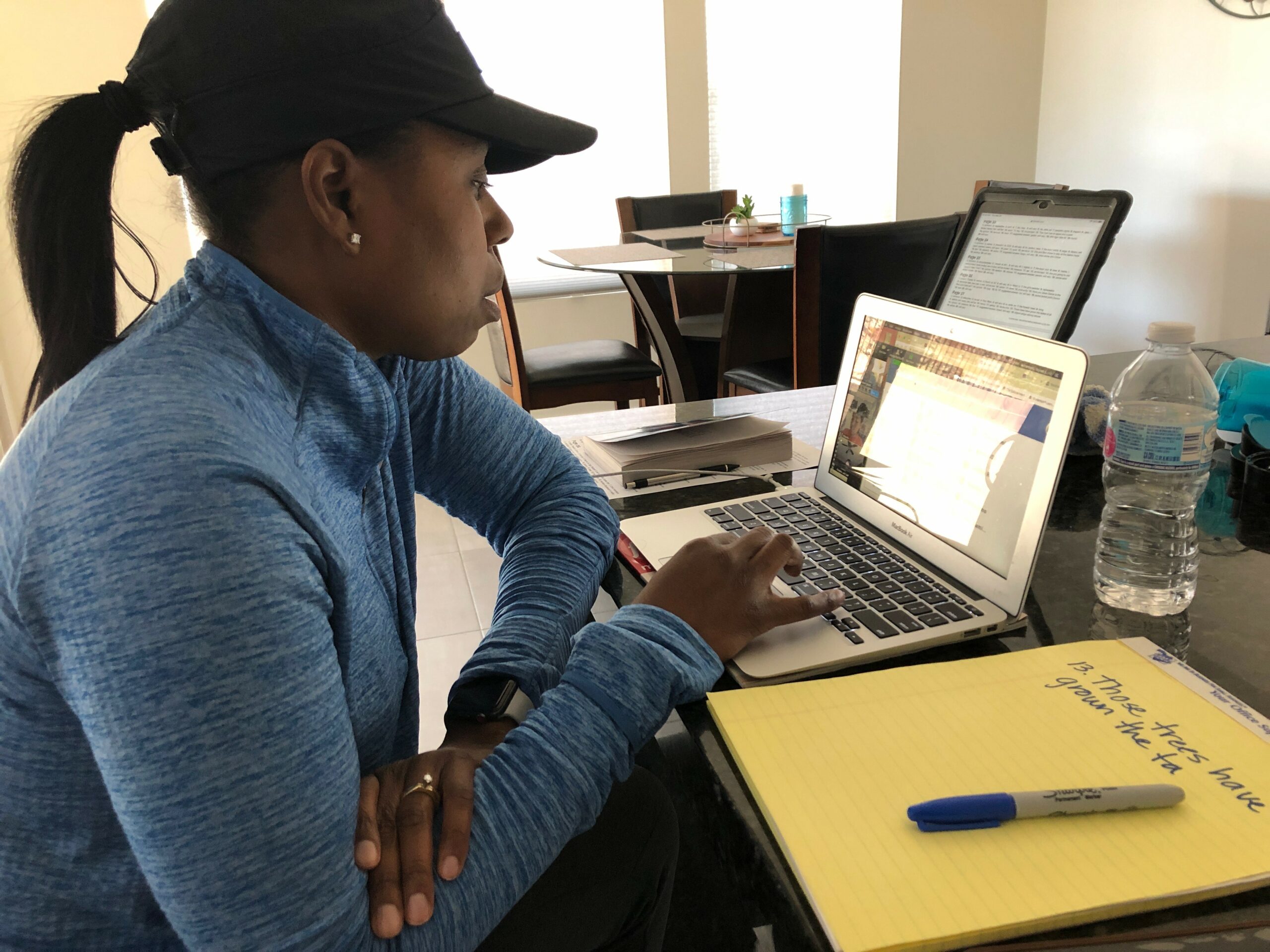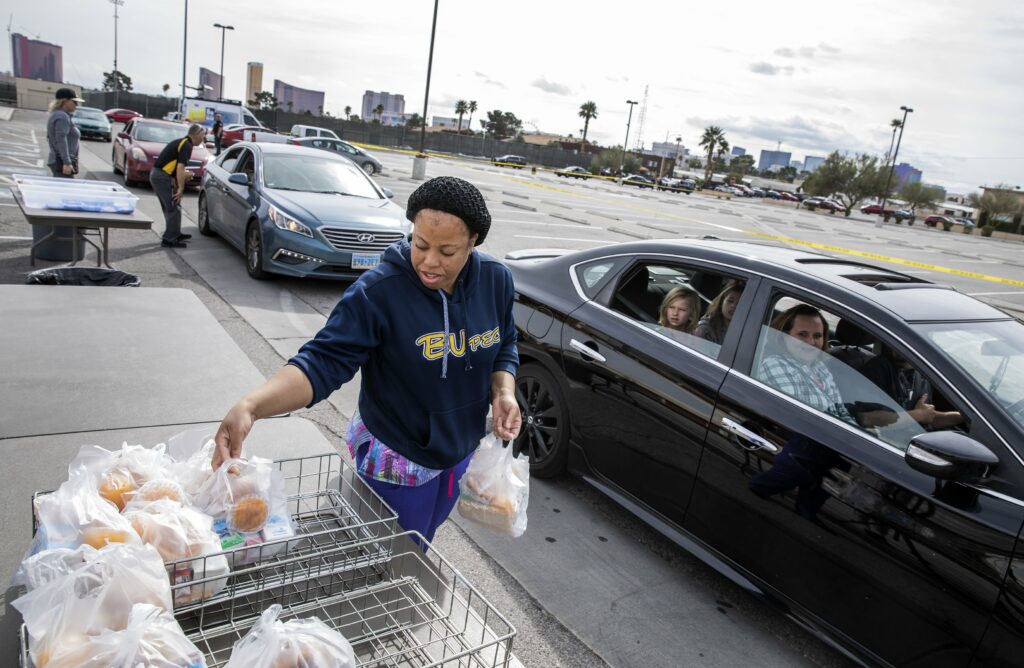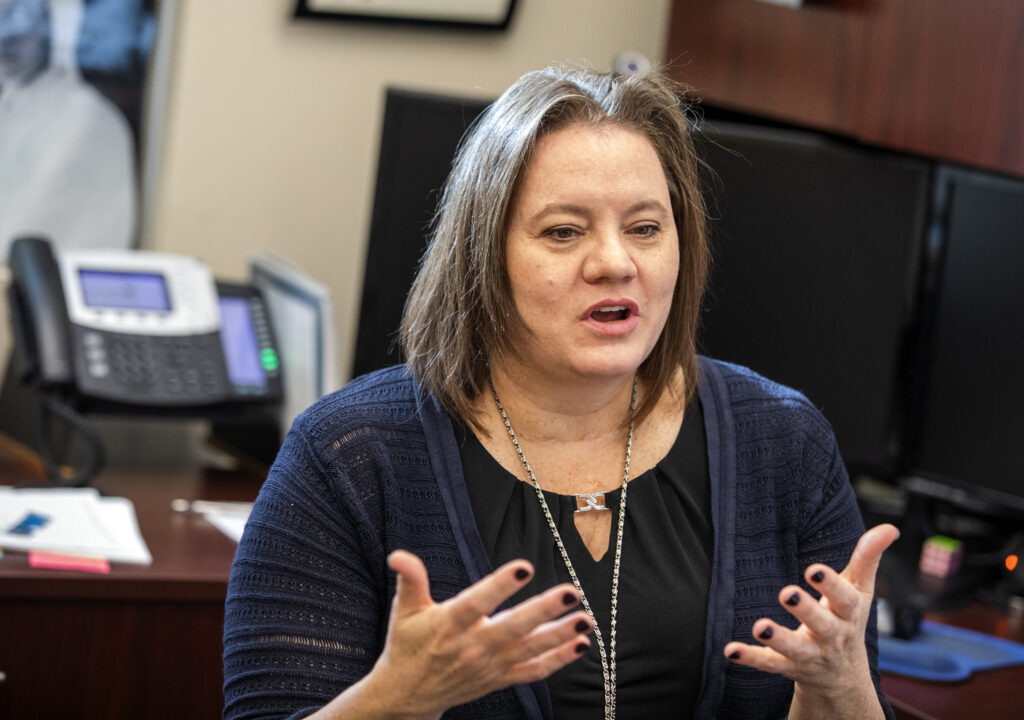Class time from the kitchen: Teachers and students adjust to distance learning but inequities remain

Teynae Richardson set some ground rules as screens lit up and dozens of faces stared back at her.
It was 10 a.m. on Tuesday, one day after Nevada schools were ordered to begin distance learning amid the statewide coronavirus closures. Richardson, a fifth-grade teacher at Heard Elementary School in northeast Las Vegas, had started virtual classroom sessions the previous week, but the routine was still a work in progress.
“We are going to start in two minutes, so make sure you have everything,” she said, rattling off items such as a notebook, pencil and water.
Chatter erupted on the Zoom video-conferencing platform as 43 students holed up in their bedrooms, family rooms or kitchens reveled in the opportunity to see their peers. And, in this new learning environment, it was already clear that some perks existed.
“I’ve got some apple juice,” one student announced.
But the age-old expectation of coming to class prepared hadn’t disappeared either.
“First thing, before we get started, if you have a notepad, hold it up in the screen,” Richardson said, bringing the class to order and nodding as she surveyed the response. “Good, good, good. Pencil? Something to write with?”
Satisfied with their preparedness, Richardson turned to virtual social etiquette, which, perhaps to students’ dismay, mirrors normal classroom rules. She had muted their screens a minute earlier.
“When someone else is talking, you are not,” she said. “So I’m going to unmute you, and we are going to practice.”
For many students across the state, this is their new education reality — classes conducted via video screens, where their heads occupy tidy rows of boxes. In this education delivery method, students and staff won’t transmit COVID-19 to each other through coughs and sneezes. But technology-enabled education doesn’t guarantee learning for all students, some of whom don’t have access to the internet much less devices such as laptops, tablets or Chromebooks.
The technology divide came to the fore last week when the Clark County School District pushed back on a Nevada Department of Education request for an emergency program of distance education. The Las Vegas-area school district was the only district in the state to not submit a signed agreement form by an afternoon deadline on March 22. The rationale, Clark County Superintendent Jesus Jara explained, was that the district couldn’t mandate remote learning because of inequities that exist among students. Instead, after an emergency school board meeting on March 23, the Clark County School District submitted a modified form, saying it would “make best efforts to offer distance education to pupils.”
State Superintendent Jhone Ebert approved the district’s plan Friday, determining that it conformed with the Nevada Department of Education’s requirements as well as Gov. Steve Sisolak’s emergency directive.
Still, the discrepancy between the large, urban district and the state education department didn’t stop Clark County teachers from rolling out their own versions of distance learning this past week. Educators interviewed by The Nevada Independent described some successes and limitations along with a general acknowledgement that, no, this isn’t ideal, but it’s at least something.
“Our goal is just to give them what we can give them and just pray everything works out,” Richardson said. “We just didn’t want to do nothing.”

Seeing and solving the technology divide
Kevin Barney greeted his Advanced Placement U.S. History students on Wednesday wearing a hat he bought in Peru that sloped gently over his ears. The hat, he told them, serves a dual purpose as a waterproof shield and a bucket for carrying water.
But on this afternoon it served a third purpose as well — a conversation starter as Barney kicked off a virtual lesson with students whom he would see, under normal circumstances, at Veterans Tribute Technical and Career Academy. Now, they were convening over a video conference.
He encouraged them to use a thumbs-up emoji as a means of participation. Talking wasn’t prohibited, either, as long as they weren’t cutting each other off.
“The better we are at talking and discussing things, the more this is going to feel like a regular class,” he told them.
Of course, they all knew this was anything but ordinary.
Gov. Steve Sisolak had ordered a 30-day shutdown of schools and nonessential businesses in a bid to slow the spread of the upper-respiratory virus. Other states issued similar directives. The pandemic has upended daily life around the globe, forcing education systems into a new mode of operation. Already, the College Board, which administers the college credit-producing AP tests, had provided some relief to Barney’s students by announcing that the year-end exams would be available online, condensed to 45 minutes and limited to material covered by early March.
And so they began a review session led by Barney that touched on the Columbian exchange, which exposed Native Americans to new diseases. Suddenly, the lesson seemed a whole lot more relevant.
“Does anyone know why it’s called a novel coronavirus?” Barney said. “People haven’t been exposed to it.”
Up until the coronavirus-prompted school closure, Barney hadn’t used Zoom or other video-conferencing platforms with his students. But he wasn’t entirely new to distance learning thanks to online courses he took for his master’s degree.
He described the first Zoom sessions with his students as therapeutic. Some students cried because they missed each other. Others wanted to talk about the rapidly evolving health situation and what it would mean for grades, graduations or other events.
Several days into it, though, they had mostly adjusted to a new rhythm.
“I think one of the problems with online learning is it only works as much as the students want it to work,” Barney said. “If you’re able to stay engaged and focused, I think it’s a great way to deliver classes. But I don’t know if most high school students are in that mindset.”
In this particular class, Barney said motivation is higher given the upcoming AP tests. Only four students from this class didn’t join the virtual session. He had made contact with two of those students via email but hadn’t heard from the other two.
Even though every student at Veterans Tribute Technical and Career Academy has a school-issued Chromebook, Barney said some come from “incredibly difficult situations,” such as homelessness or being caregivers for younger siblings, that render remote learning difficult.
Add sudden job loss to the equation, he said, and students are picking up extra shifts at fast-food locations to supplement the family income.
For those acquainted with the Clark County School District, none of this comes as a huge surprise. Nearly 70 percent of the district’s students qualify for free or reduced-price lunch, and student mobility is cited as a chief concern. Twenty-three percent of students change schools during the year, often because their family moved in pursuit of lower rent.
Jara has said the school district is short about 120,000 technology devices for its student population, and even if it was able to give each child a Chromebook, access to WiFi remains a problem.
“The technology divide is one of the things that we are trying to minimize at this point as fast as we can,” Jara said in a phone interview. “But we have to be methodical. We have to be strategic and careful.”
The technology divide is particularly noticeable to Ryan Fromoltz, a video production teacher at Canyon Springs High School in North Las Vegas. Ninety-seven percent of the school’s students qualify for free or reduced-price lunch.
Fromoltz has heard that video production teachers in more affluent parts of the valley have asked their students to create video journals during the pandemic. But that’s not an option for his students, some of whom have limited data plans for their cell phones and no other reliable source of internet. So any projects that would require enhanced technology equipment or better internet access are out of the question.
“A lot of my kids, their phone is their only source of internet because their parents don’t have a computer or WiFi at home,” he said.
Fromoltz said he worries about his students’ well-being during a time when families already living on the brink financially are facing even greater challenges.
“If kids learn right now, it’ll be great, but they’re mostly fighting for survival,” he said.
Jara echoed that point, saying the health and happiness of students and their family's needs to be prioritized. From an education perspective, the superintendent said he wants to keep students engaged and learning as much as possible, but teachers won’t be taking grades right now.
“I don’t want it to be inequitable,” he said. “I don’t want to punish kids that can’t do the work because they’re dealing with so many things.”
Even so, efforts are underway to bolster distance learning. Jara said the district is using carryover federal Title 1 funds to purchase 40,000 Chromebooks, which should arrive in a week or two. He’s working with the business community to secure the other 80,000 devices needed, and, in the meantime, schools are starting to check out existing district-owned Chromebooks.
The next step is securing internet. District leaders said they’re connecting families with Cox Communications and other internet providers offering access during the coronavirus crisis.
Additionally, paper-based learning packets are being distributed to families at food pickup sites and various Siegel Suites locations. And Vegas PBS will begin broadcasting education programming for fourth- through 12th-grade students on Monday.
Local organizations are stepping to the plate as well. The Public Education Foundation and Spread the Word Nevada have teamed up and plan to distribute reading books and STEM (science, technology, engineering and math) workbooks to nearly 80,000 students over the coming months.
“The Public Education Foundation is dedicated to providing academic workbooks and classroom supplies to as many children as possible while school is out,” Judi Steele, chief executive officer of The Public Education Foundation, said in a statement. “It is critical that our community provide resources to students and families at this time, especially to students who do not have access to the internet or computers at home.”
The bottom line, Jara said, is that teachers, parents and families shouldn’t stress but simply do the best they can. The unprecedented closures and abrupt shift to online learning have left school districts from Los Angeles to New York City grappling with how to reach the most vulnerable children.
“This has amplified the inequities in our community for our children,” he said. “Hopefully, we’ll be able to address it. I'm looking forward to the conversation.”

Adjustment easier for charter and online schools
Some charter schools in Southern Nevada have reported an easier shift to distance learning, in part because of their size.
Nevada Prep distributed about 140 Chromebooks and other supplies, such as chargers, headphones, books, whiteboards and markers, in the two days after the governor ordered the statewide school closures, Principal David Blodgett said. Another 40 computers have been deployed since then.
School leaders also helped families fill out Cox Communications forms for internet access and loaned mobile hotspots to those awaiting installation. Now, with virtual classes operating daily, Blodgett said it’s almost “business as usual.”
“We are small and nimble (CCSD has more schools than we have humans), so we don't claim to have the same challenges they have,” he wrote in a followup email after a phone interview. “But, I'm still incredibly proud of our team, and I think they've responded as well as anyone to this pandemic.”
Ben Salkowe, principal of Equipo Academy, said he has been pleasantly surprised by the flurry of text messages and emails between staff and families. The pandemic-created closure has led to a sharp increase in parent engagement, he said. The charter school coordinated a virtual town hall with parents and has been communicating regularly about how families can pick up food, hygiene items or school supplies.
Salkowe called the current situation a “big puzzle” that will aid educators in the long run.
“I wouldn’t choose to be in this situation,” he said, “but there are some things that will make us even stronger when we come out of it.”
Officials from Nevada Connections Academy — an online charter school with an uncertain future — said the pandemic has highlighted the education purpose it serves each day, regardless of the pandemic. In January, the State Public Charter School Authority Board voted to deny the school a charter renewal because of lackluster student performance. Nevada Connections Academy has filed a lawsuit against the Charter Authority in a bid to stop the closure.
“We are kind of relevant now, which is interesting,” said Heather Engelhardt, the school leader of Nevada Connections Academy, which serves roughly 3,300 students statewide. "It’s interesting to watch that come full circle.”
Engelhardt advised teachers and families adjusting to online education to create a designated work space as well as a schedule.
Patience and understanding are also key, said Andrea Connolly, principal of Nevada Learning Academy, an online school that’s part of the Clark County School District. Teachers new to Nevada Learning Academy receive a mentor and heavy training during their first year — a luxury educators don’t have in this current transition.
“Relax and remember that there’s going to be bumps and mistakes,” she said. “No one is going to transition perfectly. Everyone should be kind to themselves.”
Brianna Cotter, a biology teacher at Sierra Vista High School, said she’s modifying her virtual lessons on the fly, which is something she does in a brick-and-mortar classroom, too. If a lesson or lab activity doesn’t go as planned in one period, she makes tweaks before the next set of students enter.
On the plus side, she said, online learning forces students to be self-starters. Cotter has had several dozen students join a virtual book club on top of their required distance learning assignments.
But for all that can be replicated online, some experiences simply cannot happen outside the classroom. For instance, students don’t have access to lab supplies like petri dishes or sterile cotton swabs, which means no hands-on activities during their evolution unit right now.
“We have access to virtual labs, but it still doesn’t beat the hands-on (experience),” Cotter said. “They really want to come back.”
Richardson, the fifth-grade teacher at Heard Elementary School, shares that sentiment. Although educators are trying to mirror the normal classroom experience, she said it’s difficult to foster organic discourse or gauge students’ body language. But Richardson said she’s viewing this as a learning moment as much for herself as it is for her students.
“I gotta rejoice in the little things,” she said. “I’m rejoicing in the fact that they’re trying and making an attempt.”
On Tuesday morning, her fifth-grade students took turns announcing the books they’re reading at home — “Diary of a Wimpy Kid,” “Harry Potter and the Chamber of Secrets,” “Anne Frank: The Diary of a Young Girl,” “The Da Vinci Code” and so on.
Richardson smiled and nodded.
